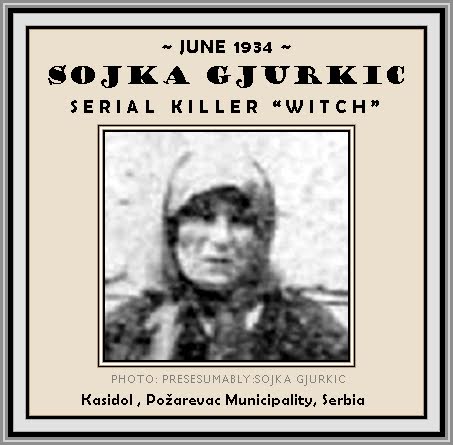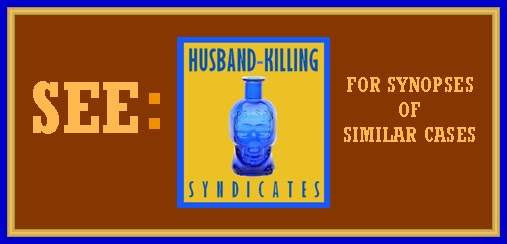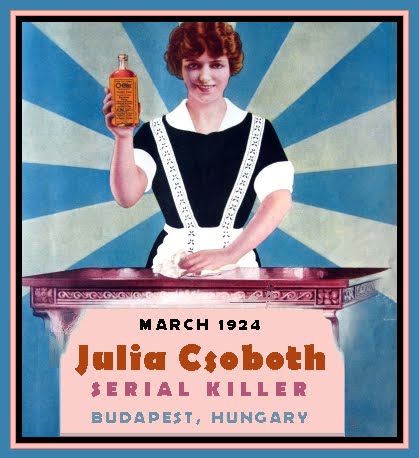FACTS which contradict what is taught in the universities and which even run counter to the assumptions made by critics of misandry.
Sunday, September 30, 2018
False Rape Accusations: Important New Research (2017)
Saturday, September 29, 2018
Marie Wewerka: Serial Baby-Killing Mom – Bohemia, 1909
Viktoria Kecskes, Serial Baby Killing Grandmother – Serbia, 1904
Josefine Wilczynska, Serial Baby Killer Child Care Provider – Poland, 1893
***
For more cases of “Baby Farmers,” professional child care providers who murdered children see The Forgotten Serial Killers.
***
Sojka Gjurkic, "Baba Sojka," Serial Killer - Serbia, 1934
For more than two dozen similar cases, dating from 1658 to 2011, see the summary list with links see: The Husband-Killing Syndicates
***
Marie Josefowitsch, Ukrainian Serial Baby Killer - 1902
***
***
Marie Blicenzyk, Polish Serial Baby Killer - 1907
***
To learn more details about murderous child care providers in history, including baby farmers, adoption agents and baby sitters, see “Death on the Baby Farm,” by Robert St. Estephe, Female Serial Killer Index.
For more cases of “Baby Farmers,” professional child care providers who murdered children see The Forgotten Serial Killers.
***
[92-6/2/19]
***
Julia Csoboth, Hungarian Serial Killer Housemaid, 1924
FULL TEXT (translated): Budapest, March 5. – Today the poisoning trial against the servant girl Julia Csoboth was scheduled. Csoboth, who was employed by the carter Karl Pollak as a housemaid, is involved in an affair with her employer. One day his wife died and soon after his little daughter died. Even Pollak’s mother became ill with symptoms of strychnine poisoning. Now Csoboth was snared, and despite the denial of those arrested, the investigation showed it probable that Csoboth wanted to avenge herself on the Pollak family because, after the death of the wife, he had failed to marry his mistress. One day before the negotiation, Csoboth managed to escape from custody. She fled to Romania.
[(“Escape of a poison killer from custody.”) “Flucht einer Giftmörderin aus der Untersuchungshaft. Budapest, 5. März.” Tiroler Unzeiger (Innsbruck, Austria), Mar. 7, 1924, p. 4]
***
FULL TEXT: From Budapest 4. ü., we are telegraphed: Tomorrow the trial of the poisoner Julia Csoboth should have started, and there is great interest in her.
Julia Csoboth was in the service of Karl Kollak, with whom she had a relationship. She also endeavored to marry him even though he was married. This case is similar to that of the Milica Vukobrankovics, only the outcome here is a much more tragic one. Suddenly Pollak's wife died and later his daughter too, without it being possible to establish the cause of death. Julia Csoboth now hoped that Karl Pollak would marry her.
But since Karl's father did not consent to the marriage, Csoboth wanted to take revenge on Philipp Pollak too. One day Philipp Pollak suffered from severe stomach cramps; he sent for his doctor, who found that the patient had been poisoned with strychnine. The doctor immediately pumped Pollak's stomach, and a few days later the old man regained his health. When the case examination discovered the two deaths in the family, the public prosecutor immediately opened an investigation.
The bodies of Pollak's wife and daughter were exhumed and their intestines examined by the chemical institute. No trace of poisoning could be found in these parts of the body, but it is known that in every case of poisoning the poison disappears from the corpse after a certain time.
So that would not prove that Julia Csoboth had not poisoned you wife and daughter Pollaks. All the evidence and evidence suggest that the girl caused the deaths of them either by poison or in some other way. Julia Csoboth continually denied having committed the crime and managed to escape the remand prison just before the main trial.
The evidence indicates that the Csoboth is currently in Romania and as a result the prosecutor has taken steps to obtain her extradition. The negotiation is postponed until the Csoboth is delivered to Hungary.
["Escape of the poison mixer Julia Csobotoh." Neues Wiener Tagblatt (Vienna, Austria), Mar. 5, 1924, p. 14]
***
FULL TEXT: Budapest, March 5th. - The poisoning trial against the maid Julia Csoboth was set for today. This case is very reminiscent of that of Milica Vukobrankovic, but it had a much more tragic outcome than the Viennese poisoning affair. Julia Csoboth worked as a housemaid for the wagon owner Karl Pollak. He had a relationship with her and also promised her marriage, although he was already a family man. One day his wife died and soon after that his baby daughter. A natural death was assumed. However, Karl Pollak did not keep the promise he made to the maid because his father Philipp refused to consent to this connection. One day old Pollak felt severe stomach cramps. The doctor found poisoning with strychnine.
By pumping out the stomach immediately, the old man was saved. However, this incident drew suspicion from the sudden unexplained death of the young woman Pollak and her child. The two bodies were exhumed. An examination of the intestines gave a negative result, but the doctors stated that with every poisoning, the poison disappears from the corpse after a certain time. Julia Csoboth, who was arrested, denied any guilt for the deaths of her employer's wife and daughter. Despite this, charges were brought against them. One day before the trial, Julia Csoboth managed to escape from the remand prison. She is likely to have fled to Romania.
[“A Hungarian Vukobrankovic.” Innsbrucker Nachrichten (Innsbruck, Austria), Mar. 8, 1924, p. 8]
***
FULL TEXT: ~ Flucht einer Giftmörderin ans der Untersuchungshaft.
Budapest, 5. März. – Für heute war der Giftmordprocess gegen die Dienflmagd Julia Csoboth anberaumt. Die Csoboth, die bei dem Fuhrwerksbesitzer Karl Pollak als Hausgehilfin bedienstet war, unterheilt mit diesem ein Berhältnis. Eines Tages starb seine Frau, bald barauf seine kleine Tochter. Auch die Mutter Pollaks erkrankte unter Anzeichen einer Strychninvergiftung. Nun wurde die Csoboth verhastet und die Untersuchung ließ es trotz des Leugnens der Verhafteten als wahrscheinlich erscheinen, dass die Csoboth sich an fer Famille Pollaks rächen wollte, weil dieser nach dem Tode seiner Frau sein der Cloboth gegebnes Ehevensprechen nicht einggehalten hatte. Einen Tag vor der Verhandsung ist es nun der Csoboth gelungen, aus denm Untersuchsgefängnis zu entkommen. Sie Durchte sich nach Rumänien geslüchtet haben.
[“Flucht einer Giftmörderin aus der Untersuchungshaft. Budapest, 5. März.” Tiroler Unzeiger (Innsbruck, Austria), Mar. 7, 1924, p. 4]
***
FULL TEXT: Aus Budapest 4.ü., wird uns telegraphiert: Morgen hätte der Prozeß gegen die Giftmischerin Julia Csoboth beginnen sollen, dem großes Interesse entgegen gebracht wird.
Julia Csoboth war im Dienste bei Karl Kollak, mit dem sie ein Verhältnis hatte. Sie war auch bestrebt, ihn zu heiraten, obzwar er verheiratet war. Dieser Fall gleicht dem der Milica Vukobrankovics, nur daß der Ausgang hier ein viel tragischerer ist. Plötzlich starb die Frau Pollaks und später auch seine Tochter, ohne daß man die Todesursachen hätte seststellen können. Nun hoffte Julia Csoboth, daß Karl Pollak sie heiraten werde.
Da aber der Vater Karls seine Ein willigung zur Heirat nicht gab, wollte die Csoboth auch an diesem, Philipp Pollak, Rache nehmen. Eines Tages litt Philipp Pollak stark unter Magen krämpfen; er ließ seinen Arzt holen, und dieser stellte fest, daß der Patient mit Strychnin vergiftet sei. Der Arzt ließ Pollak sofort den Magen auspumpen, und einige Tage später erlangte der alte Mann wieder seine Gesundheit. Daman durch diesen Fall auf die beiden Todes fällein der Familie aufmerksam wurde, leitete der Staats anwalt sofort eine Untersuchung ein.
Man exhumierte die Leichen der Frau und Tochter Pollaks und ließ ihre Gedärme durch das chemische Institut untersuchen. Man konnte zwarin diesen Körperteilen keine Spur einer Vergiftung finden, aber es ist ja bekannt, daß bei jedem Vergiftungsfall nach einer gewissen Zeit das Gift aus dem Leichnam verschwindet.
Damit wäre also noch nicht der Beweiserbracht, daß Julia Csoboth dir Frau und Tochter Pollaks nicht vergiftet hätte. Alle Anzeichen und Zeugen aus sagen deuten darauf hin, daß das Mädchen entweder durch Gift oder auf irgend eineandre Weise den Tod der beiden verursacht hat. Julia Csoboth Leugnete fortwährend, die Tatbegangen zu haben, und esgelang ihr, gerade vor der Haupt verhandlung aus dem Untersuchungsgefängnis zu entkommen.
Die Spuren weisen daraufhin, daß sich die Csoboth gegenwärtig in Rumänien aufhält, und infolge dessen hat der Staatsanwalt Schritte unternommen, um ihre Auslieferung zu erwirken. Bis zur Einlieferung der Csoboth nach Ungarn wird die Verhandlung vertagt.
[“Flucht der Gistmischerin Julia Csobotoh.” Neues Wiener Tagblatt (Vienna, Austria), Mar. 5, 1924, p. 14]
***
FULL TEXT: Budapest, 5. Marz. – Für heute war der Giftmordprozeß gegen die Dienstmagd Julia Csoboth anbevaumt. Dieser Fall erinnert sehr an den der Milica Vukobrankovic, hatte aber einen viel tragischeren Ausgang als die Wiener Giftmordasffäe. Julia Csaboth war bei dem Fuhrwerksbesitzer Karl Pollak als Hausgehilfin bedienstet. Er hatte mit ihr ein Verhältnis und versprach ihr auch die Heirat, obwohl er bereits Familienvater war. Eines Tages starb seine Frau und bald daraufseine kleine Tochter. Man nahm einen näturlichen Tod an. Karl Pollak löste aber sein dem Dienstmädchen gegebenes Heiratsversprechen nicht ein, da sein Vater Philipp die Einwilligung zu dieser Verbindung verweigerte. Der alte Pollak spürte nun eines Tages starke Magenkrampfe. Der Arzt stellte Vergiftung mit Strychnin fest.
Durch eine sofort eingeleitete Auspumpung des Magens gelang es, den alten Mann zu retten. Dieser Vorfall lenkte aber den Verdacht aus den plötzlichen unaufgeklärten Tod der jungen Frau Pollak und ihres Kindes. Man exhumierte die beiden Leichen. Eine Untersuchung der Gedärme ergab zwar ein negatives Resultat, aber die Aerzte erklärten, daß bei jeder Vergiftung nach einer gewissen Zeit das Gift aus dem Leichnam verschwindet. Julia Csoboth, die verhaftet wurde, leugnete jede Schuld an dem Tode der Frau und der Tochter ihres Dienstgebers. Trotzdemwurde die Anklage gegen sie erhoben. Einen Tag vor der Verhandlung ist es nun Julia Csoboth gelungen, aus dem Untersuchungsgefängnis zu entkommen. Sie dürfte nach Rumänien geflüchtet sein.
[“Eine ungarische Vukobrankovic.” Innsbrucker Nachrichten (Innsbruck, Austria), Mar. 8, 1924, p. 8]
***





















